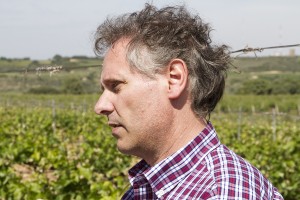 After touching down in Bilbao, we made our way into the land of wine legends – Rioja. We came over the crest of a hill and there it was. Sprawling rolling vineyards interspersed with small ones. We wound our way into the town of Logroño, where at 8:30pm, the temperature hovered in the 80s. I joined a group of fellow wine lovers and we hit the streets for a tapas tour. At each stop, we sampled a bottle or two of Campo Viejo wine. We noshed on Riojanito (chorizo topped with a fried quail egg, Careta de Cerdo (pig snout), Sardina Ahumada (smoked sardine), Piparras Frescas (sautéed green peppers), divinely fresh bread and more with Campo Viejo Tempranillo, Garnacha, Reserva and Gran Reserva, all in advance of our visit to the winery the following morning. I dragged my jet-lagged body through the warm and bustling streets of Logroño back to the Hotel Marques de Vallejo and crashed.
After touching down in Bilbao, we made our way into the land of wine legends – Rioja. We came over the crest of a hill and there it was. Sprawling rolling vineyards interspersed with small ones. We wound our way into the town of Logroño, where at 8:30pm, the temperature hovered in the 80s. I joined a group of fellow wine lovers and we hit the streets for a tapas tour. At each stop, we sampled a bottle or two of Campo Viejo wine. We noshed on Riojanito (chorizo topped with a fried quail egg, Careta de Cerdo (pig snout), Sardina Ahumada (smoked sardine), Piparras Frescas (sautéed green peppers), divinely fresh bread and more with Campo Viejo Tempranillo, Garnacha, Reserva and Gran Reserva, all in advance of our visit to the winery the following morning. I dragged my jet-lagged body through the warm and bustling streets of Logroño back to the Hotel Marques de Vallejo and crashed.
I was full of anticipation as we neared the winery. Our itinerary had us spending the morning with Vineyard Manager Mario Ezquerro followed by lunch and then an afternoon with Chief Winemaker Elena Adell. Mario is clearly passionate about his work. Through a translator, he told us the winery sources 90% of its grapes. They have 64,000 hectares (about 160,000 acres) under contract with 800 growers. Mario explained that with so many growers, it’s critical they share the same vision. It’s simple. If the grapes don’t meet his strict standards, he won’t buy them. Rioja is broken up into three regions; Rioja Alta, Rioja Baja and Rioja Alavesa and Campo Viejo has grapes planted in all three regions, each posing unique growing conditions.
There’s an experimental vineyard at Campo Viejo with all of Rioja’s grape varieties including Garnacha, Tempranillo, Viura, Graciano and Mazuelo planted there. Ezquerro is able to see how the grapes respond to different growing techniques and share his finding with the growers he has across Rioja. Tempranillo Blanco and Garnacha Blanca are relatively new varieties and Campo Viejo has them planted in all three regions to see where they thrive. If you take a close look at the vines, you’ll see a small red ribbon on every fourth vine. They release pheromones that confuse butterflies and keep them from laying their eggs on the vines. It’s just one of many innovative techniques that Campo Viejo employs. He an avid learner, always looking for better growing techniques.
 “With great knowledge you stay ahead, but it comes with great responsibility. Respect what you have, respect the path that brought you here, respect what you have to do and make it grow.” There’s a keen focus on employing sustainable practices in the vineyards. With four different ecosystems, it’s another challenge for Mario and his team, but one he embraces. They make a special effort to attract flora and fauna. They’re planting trees and making their property inviting to owls, hawks and other birds.
“With great knowledge you stay ahead, but it comes with great responsibility. Respect what you have, respect the path that brought you here, respect what you have to do and make it grow.” There’s a keen focus on employing sustainable practices in the vineyards. With four different ecosystems, it’s another challenge for Mario and his team, but one he embraces. They make a special effort to attract flora and fauna. They’re planting trees and making their property inviting to owls, hawks and other birds.
 Following a stroll through the vineyards, it was time for lunch and winemaker Elena Adell joined us. A long table was set overlooking the vineyards, laden with freshly baked bread, cheese, jamon and Campo Viejo wines. We savored course after savory course and prepared ourselves for the afternoon’s tour of the winery with Elena. I’ll share that visit with you in the near future. In the meantime, grab a bottle of Campo Viejo Tempranillo next chance you get. It’s become one of my favorites.
Following a stroll through the vineyards, it was time for lunch and winemaker Elena Adell joined us. A long table was set overlooking the vineyards, laden with freshly baked bread, cheese, jamon and Campo Viejo wines. We savored course after savory course and prepared ourselves for the afternoon’s tour of the winery with Elena. I’ll share that visit with you in the near future. In the meantime, grab a bottle of Campo Viejo Tempranillo next chance you get. It’s become one of my favorites.
Tom Plant launched WINEormous in 2009 and is a member of the International Food Wine and Travel Writers Association. Based in Temecula, California, he offers intimate winery tours for no more than seven people. Tour details and pricing are available at www.temecula-tours.com. Call now to book your Temecula Winery Tour at (951) 907-9701! Ask about special discounts.



